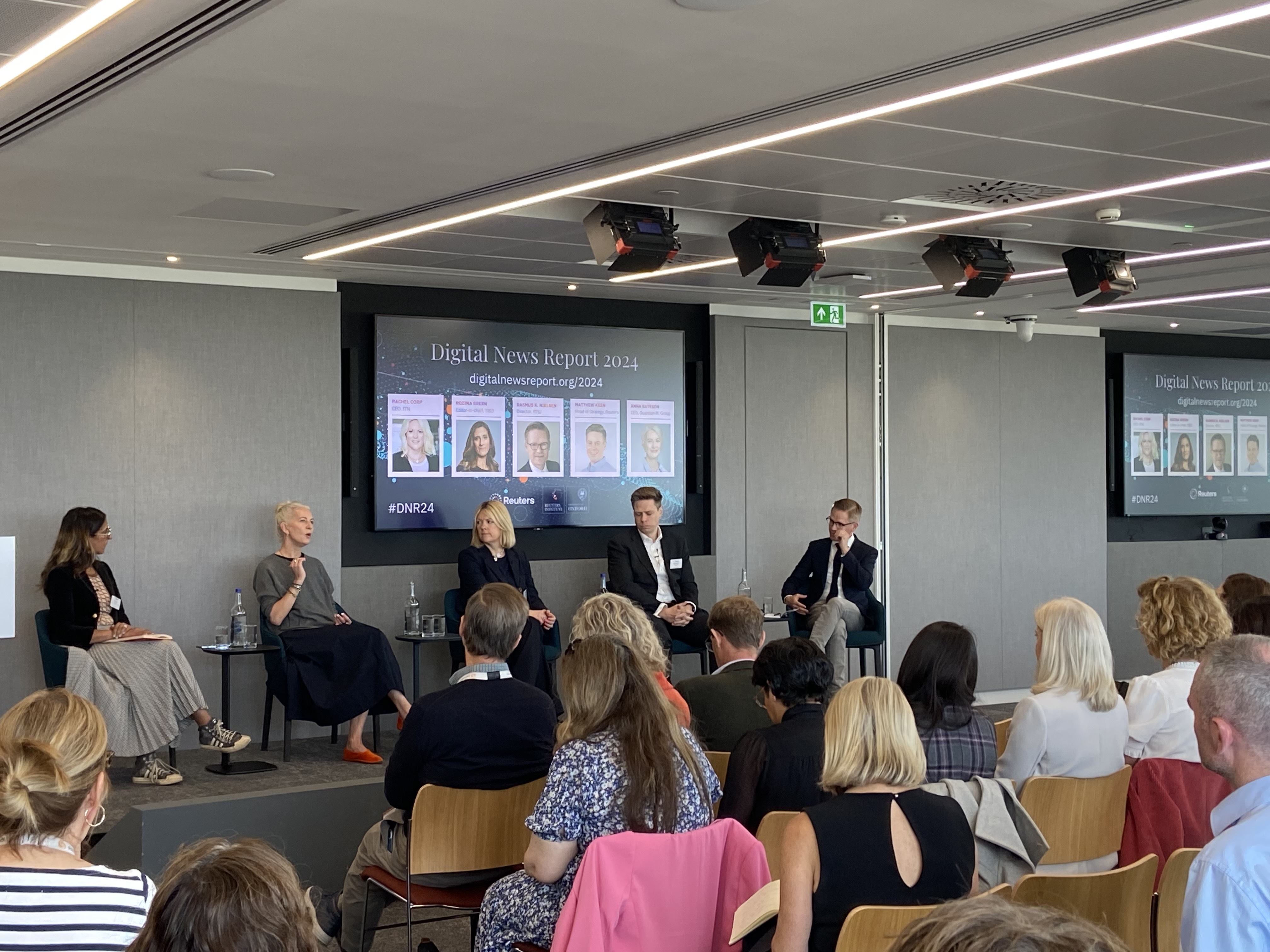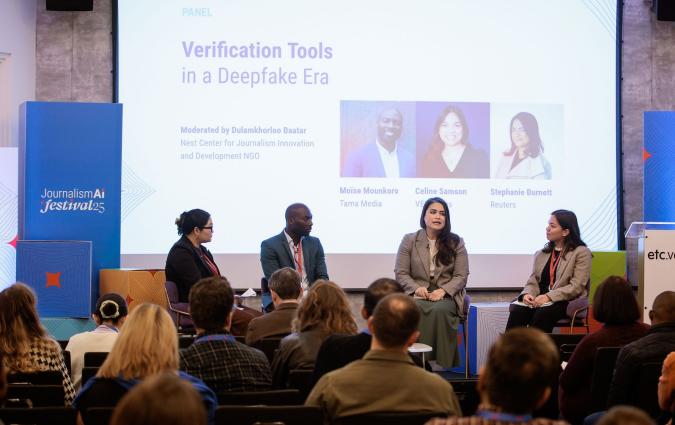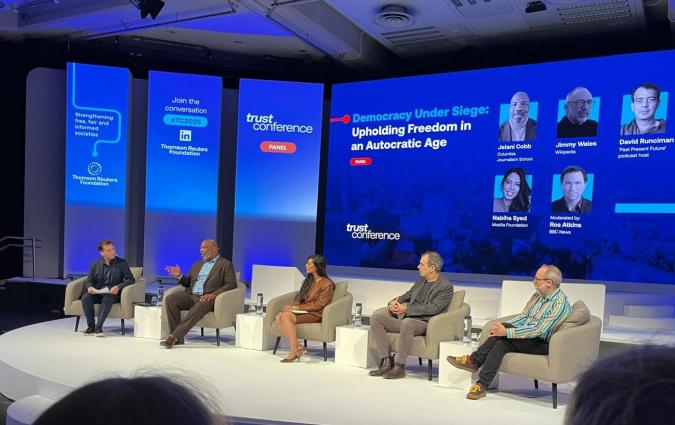Betting on direct relationships in the face of AI: Our panel on how to survive this era of platform resets

Our panel from left to right: Rozina Breen, Anna Bateson, Rachel Corp, Matthew Keen, and Rasmus Nielsen
How can journalism face a new wave of disruption, fuelled by the rise of generative AI and a series of challenging platform resets? This question was at the heart of the global launch event of this year’s Digital News Report, which took place on Monday 17 June at Reuters HQ in London.
Our panellists argued news brands should build meaningful relationships with their core audiences while exploring new platforms and new formats and learning from the rise of news influencers documented by the report.
Jane Barrett from Reuters and Will Church from TRF welcomed more than 100 researchers, editors and media executives to the event, which featured a presentation by lead author Nic Newman followed by a panel moderated by the Institute's director Rasmus K. Nielsen, with Anna Bateson, CEO of the Guardian Media Group; Rachel Corp, CEO of ITN; Matthew Keen, Head of Operations and Strategy at Reuters; and Rozina Breen, editor-in-chief of The Bureau of Investigative Journalism.
Watch the launch
Is a platform reset underway?
The panel discussed a series of platform resets reshaping news consumption, including the decline in the use of Facebook for news, an increase in the use of video platforms such as TikTok and the enduring popularity of YouTube.
Why do people increasingly like short-form video over more traditional news formats? During his presentation, Newman pointed to these reasons: “The sense of authenticity; the trust that it doesn't come with the sort of agendas and bias that they sometimes see from social media; convenience, which is partly about the short format; and also the fact that the algorithm aligns with your personal interests, that it's much more relevant. Video also gives audiences a range of perspectives that people really like as well.”
As platforms like Facebook and X shift away from news content, audiences flock towards TikTok and YouTube. According to this year’s report, two-thirds of respondents now watch short news videos and over half watch longer news video offerings.
Our panellists were well aware of this trend. “The fact that video is taking off is good for us,” said Rachel Corp, CEO of ITN. “We're seeing growth across all video platforms and we are reaching audiences in different ways.”
Corp said that this trend has gone beyond short video and bled over to other categories, with Channel 4 News dispatches being watched massively on YouTube after Hamas attacked Israel on October 7th.
However, panellists raised some caution in attempting to replicate the style of news influencers or the kind of catchy videos that sometimes go viral. “Not all video is the same,” said Anna Bateson, CEO of The Guardian Media Group. “How capable are you as an organisation of experimenting with the different needs of those platforms and delivering against it while still being true to yourselves?” Bateson advised news organisations to work with video in a way that is authentic to them rather than try to imitate content that does not fit within the DNA of a news organisation.
Welcoming in the news influencers
This platform reset has turned audiences away from traditional news organisations and towards online influencers and alternative voices. Among video-based social media platforms, audiences pay more attention to alternative sources and personalities than journalists and legacy media accounts.
Several panellists stressed that journalists shouldn’t be intimidated by this trend “[Influencers] are doing something that really resonates with younger audiences. It's about authenticity of voice,” said Rozina Breen, Editor-in-Chief for The Bureau of Investigative Journalism. Breen argued that part of her current considerations is relating to audiences in an authentic, personal way combined with the journalistic expertise that their newsroom can provide.
Corp also welcomed the entry of influencers into the news space and pointed out that it is not only the young that are gravitating towards this type of content but older audiences as well. According to our special chapter on news influencers and alternative media sources, many of these voices are older, male, right-leaning commentators who are extending their influence through like-minded and mostly older communities on X and Facebook.
Corp argued that traditional media and online influencers do not necessarily compete with each other, but act as complementary sources of information for audiences that look for different perspectives.
“I don't see influencers as a threat,” Corp said. “I welcome them. There are things we have to learn about being very personal with audiences, but I think we are picking up and adapting as we go along.”
AI and disruption
The emerging role of generative AI may add a layer of disruption to this series of platform resets documented in this year’s report. The Guardian’s Anna Bateson pointed to experiments with AI in search, carried out by Google and Bing, as well as the potential of AI-generated content to “pollute and corrode the quality of the ecosystem” as new disruptors in the media sector.
The way forward for news brands through these developments is to return to their core mission and identity, she suggested before asking a few fundamental questions: “What are the truths that you have to hold on to? What do you stand for as a brand? What is it that makes you distinctive, and how do you build on that through your editorial, through journalism, to build those very real relationships?”
This might mean limiting the use of AI within the newsroom when its use doesn’t align with your needs, priorities and values.
“AI is counter-cyclical to investigative journalism in many ways. Our work is deeply human and forensic and requires a high degree of human-led decision-making,” TBIJ’s Rozina Breen said. For her newsroom, AI could be useful in terms of scale and expanding its reach. But, for the moment, “I still think it's tread cautiously and carefully,” Breen concluded.
As this year’s report showed, audiences are more comfortable with publishers using AI in ‘behind the scenes’ roles such as transcription and translation. “We want our newsroom to spend time doing what they got into being in the news for, not doing admin,” Keen said, adding that this must be done transparently and with human oversight.
This year’s report documents rising concern about what is real and what is fake when it comes to online news, with an overall average of 59% of survey respondents saying they’re concerned. In terms of platforms, people were most worried about TikTok and X.
These views create new challenges in light of the rise of generative AI. “If we continue to take the sense of our audience trusting us incredibly seriously,” Bateson said, “how the platforms then feed into that is incredibly significant as you look at a world where AI begins to essentially turn platforms into publishers because they're creating summaries and content, and it's questionable about how much you can trust that.”
Responding to a question from Holly Cook, head of product at The Economist, on inauthentic personalities, Corp pointed out that authenticity might soon shift to take on the meaning of ‘human-made’ as opposed to created with AI. She emphasised the difference between eyewitness journalism and news communicated artificially, such as through an AI presenter.
“As long as we protect the system we've got, I'm hoping that we can hold on to the value of human-made [journalism] even more,” Corp said.
Bateson agreed, arguing that the initial excitement around AI presenters will probably be short-lived: “There's this kind of wonderful transactional relationship, but you've got to believe that that's a very short-term relationship, because after a while, how could you trust this AI influencer? That belief in authenticity and the belief in the need to trust is going to persist. And I think what we'll see is a hype curve around the role of AI and avatars and influencers, and then what will come back is the importance of human opinion and authentic recommendation.”
AI technologies have contributed to the perception that detecting misinformation will become more difficult, especially around important subjects such as politics and elections. While trust in the news (40%) has remained stable over the last year, it is still four points lower overall than at the height of the Coronavirus pandemic.
To tackle this lack of trust, panellists said journalists should be more transparent about how they do what they do.
According to Matthew Keen, from Reuters, news organisations should put transparency and accuracy before being the first to get to the story.
“The importance we place on trust is above everything else even if that means that we will have to do something that's not in our best interest commercially, or that maybe means that we have to be late when it comes to breaking news,” he said. Keen added that it is also about being honest and upfront with audiences about making errors and correcting them as quickly and accurately as they can.
Building a direct relationship with audiences
In this year’s report, respondents were asked which factors were most important in defining which news outlet to trust. Accuracy, ethics, transparency, and fairness are all ranked highly as important factors for trust. Building a close relationship with audiences is one way how news organisations are trying to show people they possess those qualities and build trust among them.
"We've always thought about responsible reach. This means prioritising audiences over this idea of traffic. You need to think about direct meaningful relationships. And if they're not direct and meaningful relationships, then you have to be very honest with yourself about what you're prioritising or what sort of victories you’re celebrating,” Bateson said.
Corp stressed the value of reaching out to audiences through platforms and experimenting with different formats. “We've realised our audiences aren't just in one place and it's our duty to go and find them and deliver content wherever they are,” she said.
For those news outlets who are audience-funded, building direct relationships with audiences is even more important. “The fact that we're open to all allows us to essentially find and build audiences all around the world. And that's going to now be an incredible strength because I think that sense of international diversification is very important,” Bateson said about the Guardian’s global outlook and open ethos.
At the same time, the Guardian needs to make sure that some of these readers are willing to support its work. “It is very much about leaning into that sense of what it is that's making people want to support Guardian journalism. And it is that they're able to discover it, that it's independent, that they feel that by supporting it they can enable others to read it for free,” Bateson said.
Also important, she argued, is offering audiences something different, or additional, to what they get elsewhere: “Audiences are very astute about identifying what makes things different and significant and what matters to them.”
For Breen and TBIJ, building direct relationships with audiences also means building an inclusive newsroom and a diverse product.
“All our news services are very much anchored in communities and listening to them. [Our job is] making sure we have diversity within the newsrooms and diversity in the content that we put out. We need a vibrant, pluralist ecology in the provision of news but also pluralism internally. When we bring in new talent, we should let them be themselves and give them power,” she said.
In every email we send you'll find original reporting, evidence-based insights, online seminars and readings curated from 100s of sources - all in 5 minutes.
- Twice a week
- More than 20,000 people receive it
- Unsubscribe any time
signup block
In every email we send you'll find original reporting, evidence-based insights, online seminars and readings curated from 100s of sources - all in 5 minutes.
- Twice a week
- More than 20,000 people receive it
- Unsubscribe any time






